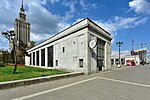Wesoła

Wesoła (Polish pronunciation: [vɛˈsɔwa]) is one of the districts of Warsaw, and has been as such since October 27, 2002. Wesoła is located in the south-eastern part of city. Wesoła received town privileges on December 17, 1968. Then, the town included Wola Grzybowska, Wesoła, Groszówka, Grzybowa, Zielona and Stara Miłosna estates. The development of the area was determined by its locality to 3 important routes. The first route, called Stary Trakt (English: Old Route), comes from Grochów, then travels through Okuniew, Stanisławów, and finally through South Podlasie towards Russia. Established near this route was Grzybowa village with Zielona (English: Green) inn and Wola Grzybowa, which now is called Wola Grzybowska. Near the second route, which comes from Prague, through Kamion, Grochowo, to Mińsk Mazowiecki, then through Terespol and Brest, the Miłosna village developed. In 1823 on the Stanisław Staszic's initiative a road was built, called Trakt Brzeski. The third route was the Warsaw–Terespol Railway, started on September 18, 1867. It comes from Warsaw to Terespol, through Siedlce and Łuków. Despite Warsaw growing and annexing new areas, there was no case where two streets shared the same name. The only exception is Wesoła, where a lot of streets have the same name, for example with streets in Warsaw. It presents many difficulties, so addresses in Wesoła are given with a 'Wesoła' annotation.
Excerpt from the Wikipedia article Wesoła (License: CC BY-SA 3.0, Authors, Images).Wesoła
Plac Defilad, Warsaw Śródmieście (Warsaw)
Geographical coordinates (GPS) Address Nearby Places Show on map
Geographical coordinates (GPS)
| Latitude | Longitude |
|---|---|
| N 52.2323 ° | E 21.008433333333 ° |
Address
Ja, zwykły szary człowiek... (Samopodpalenie Piotra Szczęsnego)
Plac Defilad
00-110 Warsaw, Śródmieście (Warsaw)
Masovian Voivodeship, Poland
Open on Google Maps










